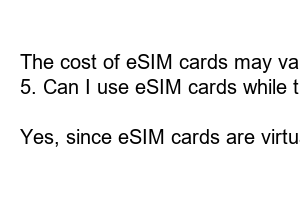유심 이심 차이
Title: Unraveling the Difference Between SIM Cards and eSIM Cards
Introduction:
When it comes to mobile devices, the terms SIM card and eSIM card are often used interchangeably, causing confusion for many users. In today’s blog post, we aim to shed light on the Difference Between SIM cards and eSIM cards, explaining the benefits and limitations of each. Join us as we delve into the world of mobile connectivity and explore the nuances of these two technologies.
1. Understanding SIM Cards:
A SIM (Subscriber Identity Module) card has been the standard for mobile devices for decades. It is a small, removable card that stores crucial information, including your mobile network credentials and contact details. SIM cards are primarily used in traditional smartphones, tablets, and other devices supporting cellular connectivity.
2. Introducing eSIM Cards:
eSIM (Embedded Subscriber Identity Module) is a revolutionary technology that does away with the physical SIM card. Instead, it relies on a built-in chip within the device, which can be programmed with the necessary network details. eSIM cards are an excellent choice for smartphones, wearables, and other smart devices that lack physical SIM card slots.
3. Physical vs. Virtual:
The key distinction between SIM cards and eSIM cards lies in their physicality. SIM cards are physical cards that must be inserted into devices, whereas eSIM cards are virtual and do not require any physical insertion or swapping of cards.
4. Flexibility and Convenience:
eSIM cards offer unparalleled flexibility as they can be programmed with multiple network profiles. This allows users to switch between cellular networks seamlessly, without the need for physical SIM card swaps. On the other hand, those who prefer using their physical SIM cards can continue doing so without hinderance.
5. Device Compatibility:
While traditional SIM cards work with a vast majority of mobile devices, eSIM cards are relatively new and may have limited compatibility. However, as the technology is gaining momentum, an increasing number of devices are now supporting eSIM functionality. It’s important to check device specifications before opting for an eSIM.
6. Network Dependence:
One limitation with eSIM cards is their reliance on network compatibility. Not all cellular providers support eSIM technology, and availability may vary depending on your region. Consequently, users may find it challenging to switch to eSIMs if their preferred network provider does not offer this service.
7. Security and Privacy:
Both SIM cards and eSIM cards offer secure authentication and encryption of user data. However, eSIMs provide an additional layer of security due to their embedded nature. Since eSIMs cannot be physically stolen or tampered with, they are considered more secure in terms of safeguarding personal information.
Summary:
In summary, while both SIM and eSIM cards serve the same purpose of providing connectivity to mobile devices, their methods differ significantly. Traditional SIM cards remain the go-to choice for many, offering widespread compatibility, while eSIM cards provide enhanced flexibility and convenience. As this technology continues to evolve, we can expect to see a growing number of devices embracing eSIM functionality, ushering in a new era of mobile connectivity.
FAQs:
1. Can I switch between SIM cards and eSIM cards on the same device?
Yes, if your device supports both SIM card and eSIM functionality, you can switch between them as needed.
2. How can I check if my device supports eSIM?
Refer to your device manufacturer’s specifications or contact their customer support to determine if your device supports eSIM functionality.
3. Can I use eSIM cards with my existing mobile plan?
Not all network providers offer eSIM functionality yet. Check with your mobile operator to see if they support eSIM technology and if it’s available for your current plan.
4. Are eSIM cards more expensive than traditional SIM cards?
The cost of eSIM cards may vary depending on your region and mobile operator. It’s best to check with your provider for specific pricing details.
5. Can I use eSIM cards while traveling internationally?
Yes, with eSIMs, you can switch to local network providers using your device’s settings, allowing for easy and cost-effective connectivity while traveling.
6. Are eSIM cards more environmentally friendly?
Yes, since eSIM cards are virtual and don’t require physical production, they contribute to reducing electronic waste, making them a more eco-friendly choice.

